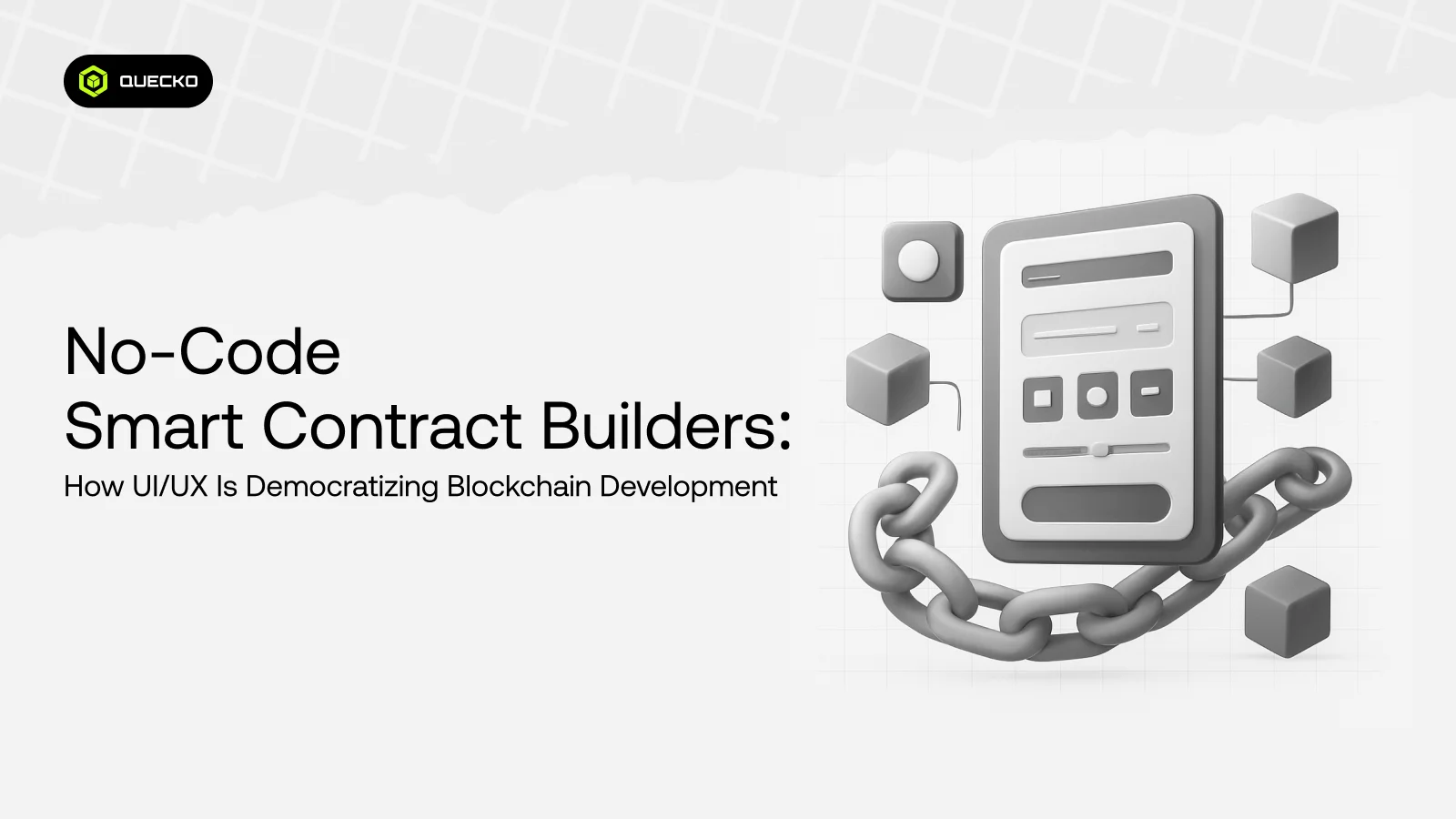Top Vulnerabilities and How to Avoid Them in Smart Contract Security
Learn common smart contract vulnerabilities and how to mitigate risks with best practices.

Smart contracts are the backbone of decentralized applications (dApps), enabling automated and trustless transactions on blockchain networks. However, their immutable and transparent nature introduces potential vulnerabilities that can be exploited if not properly secured. A single smart contract vulnerability can lead to financial loss, making it crucial to address common vulnerabilities before deployment.
From integer overflow errors to incorrect calculations, vulnerable contracts often suffer from security lapses that bad actors can leverage. Reentrancy vulnerabilities, access control vulnerabilities, and flaws in calling contracts have historically caused significant disruptions across blockchain ecosystems.
In this blog, we’ll explore the most common smart contract vulnerabilities and best practices to mitigate them without diving into code.
1. Reentrancy Attacks
Reentrancy vulnerabilities pose a serious risk in smart contract development, allowing attackers to manipulate financial transactions and drain funds unexpectedly.
What Happens?
A reentrancy attack exploits vulnerabilities in smart contract code by allowing a malicious contract to repeatedly call back into a vulnerable function before the initial execution completes. This recursive process can drain funds from the contract, leading to financial loss. Since blockchain technology ensures transparency, attackers can identify weaknesses in earlier versions of contracts and deploy sophisticated attack vectors to exploit them.
Famous Example: The DAO Hack
One of the most notorious cases in the blockchain space, the 2016 DAO attack, leveraged reentrancy vulnerabilities to siphon off millions of dollars worth of Ether. The improper handling of contract logic resulted in a staggering $60 million loss, forcing the Ethereum community to take drastic measures—including a hard fork—to mitigate the damage.
How to Prevent It?
To secure smart contract development against reentrancy attacks, implementing proper access control mechanisms is crucial. Ensuring that financial transactions occur in a single transaction rather than through repeated function calls can help limit exposure to malicious reentry attempts. Additionally, monitoring gas price fluctuations and ensuring that transactions respect the block gas limit can prevent excessive execution loops that make contracts vulnerable.
Regular audits of smart contract code help identify weaknesses before they can be exploited, allowing developers to refine contract logic for improved security. The blockchain space continues to evolve, and with it, security measures must adapt to emerging threats. By prioritizing rigorous testing and implementing secure development practices, projects can significantly reduce the risk of reentrancy attacks and protect valuable assets from loss of funds.
2. Integer Overflow & Underflow
Integer overflow and underflow are critical vulnerabilities in smart contract development that can lead to unintended financial consequences.
What Happens?
Integer overflow and underflow occur when arithmetic operations surpass a variable’s maximum or minimum limit, causing values to wrap around unexpectedly. This can lead to unintended actions, incorrect balances, or unauthorized fund transfers on blockchain platforms. Given that token prices and asset prices fluctuate, such vulnerabilities can disrupt financial stability and governance mechanisms, making them prime targets for exploitation.
Example Scenario
Imagine a poorly designed token contract where unchecked math allows attackers to manipulate token prices by artificially inflating supply. This could lead to governance attacks, impacting token holders and destabilizing the ecosystem. Additionally, a flawed withdrawal function or fallback function could be exploited to drain funds, bypassing normal verification mechanisms. Reentrant calls may further worsen these vulnerabilities, enabling attackers to repeatedly invoke functions before prior executions are finalized.
How to Prevent It?
To mitigate the risks associated with integer overflow and underflow, smart contract development teams must adopt rigorous security measures. Using SafeMath libraries (built into Solidity ≥0.8.0) ensures arithmetic operations are properly handled, preventing value wrapping issues. Enabling compiler checks helps detect potential vulnerabilities early, strengthening contract integrity. Additionally, formal verification of smart contract logic provides valuable insight into code behavior, ensuring financial transactions are securely processed.
Blockchain platforms increasingly rely on decentralized oracles to enhance security and accuracy in financial computations. Developers must validate arithmetic operations, especially in financial logic, to safeguard against potential exploits. Regular audits and proactive security assessments help identify weaknesses before they can be weaponized, ensuring the long-term stability of blockchain ecosystems.
3. Unchecked External Calls
This oversight in contract logic creates vulnerabilities that attackers can exploit, leading to manipulation attacks and financial losses.
What Happens?
Unchecked external calls are a common issue in smart contract development, often arising from the decentralized nature of blockchain technology. When a contract makes an external call—such as transferring financial assets or interacting with proxy contracts—it may assume the operation was successful without verifying the outcome. This oversight expands the attack surface, allowing bad actors to exploit vulnerabilities and execute manipulation attacks, potentially leading to loss of user funds.
Example Scenario
Imagine a blockchain project that allows users to send ETH to other contracts. If the contract does not verify whether the recipient accepted or reverted the transaction, funds could become stuck, leading to financial instability. Smart contract attacks leveraging unchecked external calls can be particularly dangerous in an ever-evolving landscape where user inputs play a crucial role. Additionally, issues related to unsigned integers can further exacerbate these security flaws, creating unintended financial consequences.
How to Prevent It?
To mitigate the risks associated with unchecked external calls, developers must implement robust security practices. Establishing strict validation mechanisms for external transactions ensures proper execution and minimizes exposure to manipulation attacks. Incorporating comprehensive verification steps within smart contract logic reduces dependency on assumptions and strengthens the contract against potential exploits.
In an ecosystem where centralized control is absent, regular security audits and proactive analysis of proxy contracts help identify weaknesses before they can be exploited. By adopting industry best practices and continuously refining security measures, blockchain projects can safeguard financial assets and uphold trust within their decentralized frameworks.
4. Access Control Flaws
Access control flaws are among the most dangerous vulnerabilities in smart contract development. Weak permission mechanisms can lead to unauthorized actions, allowing malicious actors to exploit financial transactions, manipulate governance structures, and drain user funds.
Without proper validation of user roles and transaction identifiers, blockchain platforms become susceptible to replay attacks, unintended executions, and security breaches that threaten decentralized ecosystems. Addressing access control flaws is critical to ensuring the integrity of blockchain-based applications and protecting users from potential threats.
What Happens?
Access control flaws occur when smart contract permissions are misconfigured, allowing unauthorized actions that jeopardize user funds. Missing built-in checks for user roles and transaction identifiers can expose contracts to potential threats such as replay attacks, where malicious actors reuse valid signatures to fraudulently execute transactions. If complex operations within a contract lack proper validation, attackers can manipulate mathematical operations, leading to unintended outcomes like underflow issues or excessive consumptions in loop structures.
Example Scenario
Imagine an admin-only function designed for managing protocol settings that is accidentally left publicly accessible. Without proper access restrictions, anyone could invoke the function, minting tokens or draining user funds without approval. In decentralized voting steps, access control flaws can disrupt governance by allowing unauthorized parties to manipulate results, ultimately undermining trust in the protocol.
How to Prevent It?
To mitigate access control vulnerabilities, smart contract development teams must implement role-based access control (RBAC) frameworks such as OpenZeppelin’s Ownable or AccessControl. These mechanisms enforce strict permissions based on predefined roles, ensuring that only authorized entities can perform sensitive operations. Additionally, restricting access to whitelisted addresses enhances security by limiting entry points for potential attackers.
Avoiding hardcoded privileges and using upgradeable permissions ensures flexibility in security policies, allowing the protocol team to adapt to evolving threats. Conducting regular security audits and incorporating rigorous verification mechanisms strengthens contract logic, reducing exposure to exploits. By prioritizing robust mitigation strategies, blockchain projects can safeguard user funds and maintain the integrity of decentralized ecosystems.
5. Front-Running (Transaction Order Dependence)
Front-running is a manipulative strategy where miners, bots, or malicious traders exploit transaction ordering for financial gain. By detecting pending transactions in the mempool, they strategically place their own trades first, manipulating asset prices before the original transaction is processed. This unfair advantage can disrupt decentralized markets, leading to price distortions and financial losses for unsuspecting traders.
What Happens?
Front-running is a well-known exploit in blockchain-based financial systems where miners, bots, or malicious actors manipulate transaction ordering for profit. By leveraging their ability to see pending transactions in the mempool, they strategically place their own transactions ahead of large financial trades, often leading to price manipulation. This can significantly impact the fairness and efficiency of decentralized markets, causing unintended losses for unsuspecting users.
Example Scenario
Imagine a scenario where a trader is about to execute a large decentralized exchange (DEX) swap. A front-running bot detects the pending trade and quickly places its own buy order first. This artificially inflates the asset price before the original trade is processed, forcing the trader to pay a higher price. Once the trade is completed, the bot sells the asset for a profit, exploiting the transaction order dependence to its advantage. This type of manipulation can destabilize markets and affect overall liquidity, making it a pressing concern for blockchain projects.
How to Prevent It?
Several mitigation strategies help reduce the risk of front-running attacks:
- Commit-Reveal Schemes: These mechanisms conceal transaction details until execution, preventing malicious actors from detecting and exploiting them early.
- Slippage Protection: By enforcing minimum output amounts in swaps, traders can safeguard against unexpected price fluctuations triggered by front-runners.
- Private Transaction Mempools: Specialized solutions like Flashbots enable transactions to be processed privately, minimizing exposure to front-running bots.
As blockchain technology continues to evolve, addressing front-running vulnerabilities remains essential for ensuring fair trading environments. Implementing robust security measures and transaction safeguards protects users from financial manipulation and reinforces the integrity of decentralized markets.
6. Denial of Service (DoS)
Denial of Service (DoS) attacks are a serious threat to blockchain applications, targeting the availability and efficiency of smart contracts. By exploiting vulnerabilities such as excessive gas consumption, infinite loops, or blocking mechanisms, attackers can make contracts unusable for legitimate users.
What Happens?
Denial of Service (DoS) attacks take advantage of computational limits and logical inefficiencies within smart contracts, rendering them unusable for legitimate users. Attackers manipulate contract execution by exploiting gas limits, infinite loops, or blocking mechanisms that prevent normal operations. Since smart contracts rely on a decentralized network where transactions compete for limited computational resources, bad actors can intentionally trigger excessive processing requirements, forcing contracts into a stalled state. This type of attack compromises the availability and reliability of blockchain applications, leading to significant financial and operational consequences.
Example Scenario
Consider a decentralized exchange that executes user trades through smart contracts. A malicious actor repeatedly calls a function that processes transactions, creating an infinite loop that consumes excessive gas. As a result, legitimate users attempting to execute trades find themselves unable to do so, losing opportunities while their transactions fail. This attack effectively locks the contract, preventing it from functioning as intended. Over time, this could undermine trust in the platform and cause disruption across blockchain ecosystems.
How to Prevent It?
To mitigate the risk of DoS attacks, developers should adopt several preventive measures:
- Avoid unbounded loops: Smart contracts must limit iterations over dynamic arrays and complex computations to prevent excessive gas consumption.
- Use pull-over-push patterns: Instead of automatically sending funds, smart contracts should allow users to withdraw their own funds, minimizing exposure to blocking mechanisms.
- Set gas limits for external calls: By implementing transaction caps, developers can prevent excessive processing demands that could be exploited by attackers.
Regular audits and stress testing help identify weak points in contract execution before they can be exploited. By prioritizing efficiency and security, blockchain projects can safeguard their infrastructure against DoS vulnerabilities, ensuring seamless operations for users.
7. Logic Errors & Incorrect Assumptions
Logic errors and incorrect assumptions can silently undermine smart contract security, leading to financial instability and governance failures.
What Happens?
Logic errors stem from flaws in business logic that result in unintended contract behavior. Unlike direct exploits, these vulnerabilities often emerge from incorrect assumptions made during development—such as miscalculating fees, rewards, or interest rates. If left unchecked, logic errors can create financial inconsistencies, governance failures, or loopholes that allow bad actors to gain unfair advantages. Since smart contracts operate autonomously, a single incorrect assumption can cause irreversible consequences, putting financial stability at risk.
Example Scenario
Imagine a lending protocol that calculates interest rates for borrowers. Due to a misconfiguration in its formula, the contract allows users to borrow indefinitely without incurring the intended financial penalties. This leads to a situation where borrowers can exploit the system for unlimited credit, draining liquidity and destabilizing the platform. Over time, such flaws can erode trust in blockchain applications and cause severe economic repercussions.
How to Prevent It?
Developers must implement rigorous testing and verification strategies to prevent logic errors:
- Thoroughly test all edge cases: Unit testing and fuzz testing help ensure that smart contracts handle various scenarios correctly, preventing miscalculations.
- Audit the code before deployment: Hiring security experts to review and assess contract functionality can uncover potential risks before launch.
- Use formal verification tools: Mathematically proving the correctness of business logic ensures that transactions and financial computations behave as expected.
By adhering to strict development standards and conducting comprehensive security assessments, blockchain teams can prevent logic errors from undermining the integrity of decentralized applications.
Best Practices for Secure Smart Contracts
To enhance smart contract security and minimize vulnerabilities, developers should follow industry best practices:
- Follow Secure Design Patterns: Implement strategies like Checks-Effects-Interactions (CEI) and pull payments to reduce risk.
- Use Audited Libraries: Rely on trusted security libraries like OpenZeppelin instead of writing sensitive logic from scratch.
- Test Extensively: Simulate attacks using fuzzing tools to identify potential weaknesses before deployment.
- Get Professional Audits: Security experts can evaluate contract integrity before mainnet launch, reducing exposure to exploits.
- Implement Emergency Stops: Circuit breakers provide a failsafe mechanism to halt contracts in critical situations.
- Monitor & Update Contracts: Maintain governance controls to allow necessary updates and improvements.
- Stay Informed: Keep up with the latest exploits, security threats, and regulatory changes through sources like the SWC Registry and DeFi hack reports.
Final Thoughts
Smart contract security is non-negotiable even the smallest flaw can result in catastrophic losses. By understanding these vulnerabilities and implementing defensive coding practices, developers can significantly reduce risks and protect users from financial harm. As blockchain technology continues to evolve, maintaining rigorous security standards ensures long-term sustainability and trust in decentralized applications.
Date
4 months agoShare on
Related Blogs

AI-Powered Smart Contract Wallets The Future of User-Friendly Blockchain UX
4 days ago

Using NFTs for Brand Loyalty: The Next Big Marketing Shift
5 days ago

How Tokenized Real-World Assets Are Reshaping Finance in 2025
6 days ago

No-Code Smart Contract Builders: How UI/UX is Democratizing Blockchain Development
11 days ago








